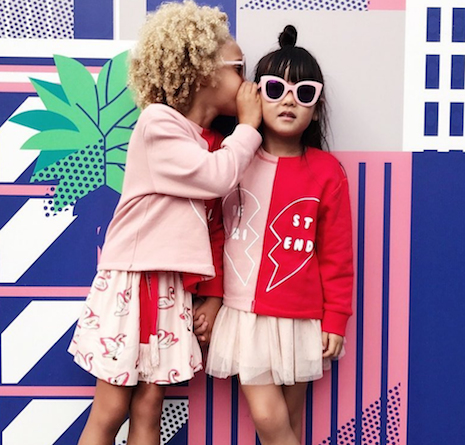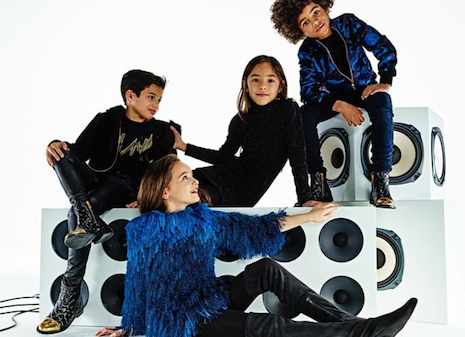 Childrenswear is growing category. Image credit: Baby Dior
Childrenswear is growing category. Image credit: Baby Dior
In the last five years, growth in the childrenswear sector has surpassed men and women’s fashions to account for 12 percent of the overall apparel category, according to a new report from Fashionbi.
Children make up a quarter of the total world population of 7.5 billion, and understandably, the countries with the highest birth rates, mainly African and Asia Pacific nations, have the biggest need for children’s clothing and accessories. The demand for childrenswear in places such as India and Indonesia is on par with emerging luxury markets due to consumers having access to disposable income, opening up opportunities for retailers.
"[The children's clothing category has evolved due to] appearance of the adult trends such as gender neutrality and the athleisure in the children's apparel," said Yana Bushmeleva, chief operating officer at Fashionbi, Milan. "[There has also been] growth of the online business of the childrenswear [and] a new business model via subscription boxes."
Outfitting the next generation
Per Fashionbi’s "Global Childrenswear Market" findings, Asia Pacific’s children’s clothing market is projected to reach 65.1 billion euros, or $77.9 billion at current exchange rates, by 2020. In 2015, the market in the region was worth 44.1 billion euros, or $52.8 billion.
The category’s growth in Asia Pacific is tied to presence of aspirational brands such as Uniqlo, Adidas, H&M and Nike.
The Indian market is also attractive to childrenswear brands as 29 percent of the population is under 14 years old. Growing at a rate of 10 percent per year, children’s sales are expected to reach $24 billion by 2020.
In established markets such as the United Kingdom, the category performs well also. The U.K. children’s apparel sector is likely to grow by 13.2 percent in the next five years to 6.1 billion pounds, or $7.8 billion.
Fashionbi associates the categories performance in established Western markets to older parents who have higher disposable incomes to spend on high-end, luxury children’s clothes (see story).
 Kering-owned Stella McCartney makes sustainable children's apparel and accessories. Image credit: Stella McCartney
As such, online retailers that cater to adult consumers have started childrenswear departments.
For example, in 2013 Net-A-Porter registered the domain name Petite-à-Porter to sell high-end childrenswear.
Also, Farfetch launched a children’s division in 2016, growing its offerings from nine brands and 19 boutiques to 70 brands and 30 boutiques since launch (see story).
The world’s largest online luxury children's wear store Childrensalon began in 1952 as a small London business and sells 800,000 items per year in 110 countries. The retailer carries 280 designer brands and in 2015, Childrensalon saw its revenues increase by 51 percent to 42.7 million pounds, or $55.1 million.
Promotions for childrenswear by individual brands and retailers occur throughout the calendar year but are most heavily associated with the back to school season between July and September.
After the holiday season, back to school shopping in the United States accounts for the highest spend of clothing and accessories. Fashionbi predicts back to school spending will account for 55 percent of 2017 total spending, an increase of 10 percent from the year-ago.
Kering-owned Stella McCartney makes sustainable children's apparel and accessories. Image credit: Stella McCartney
As such, online retailers that cater to adult consumers have started childrenswear departments.
For example, in 2013 Net-A-Porter registered the domain name Petite-à-Porter to sell high-end childrenswear.
Also, Farfetch launched a children’s division in 2016, growing its offerings from nine brands and 19 boutiques to 70 brands and 30 boutiques since launch (see story).
The world’s largest online luxury children's wear store Childrensalon began in 1952 as a small London business and sells 800,000 items per year in 110 countries. The retailer carries 280 designer brands and in 2015, Childrensalon saw its revenues increase by 51 percent to 42.7 million pounds, or $55.1 million.
Promotions for childrenswear by individual brands and retailers occur throughout the calendar year but are most heavily associated with the back to school season between July and September.
After the holiday season, back to school shopping in the United States accounts for the highest spend of clothing and accessories. Fashionbi predicts back to school spending will account for 55 percent of 2017 total spending, an increase of 10 percent from the year-ago.
With digital channels a main point of research for luxury consumers, brands including Gucci, Neiman Marcus and Oscar de la Renta have all reached out to these shoppers via digital campaigns (see story). Who wears what As with adults, childrenswear trends are inspired by celebrity dressing. Fashionbi found that celebrity kids have the same selling power as their famous partners when it comes to brand endorsement. For example, Kim Kardashian West’s daughter North inspired Balmain’s creative director Olivier Rousteing to design a children’s collection of mini-me styles (see story). The younger Ms. West also sported miniature couture designs by Riccardo Tisci while he was at Givenchy.
 Balmain children's collection, fall/winter 2017. Image credit: Balmain
A prime example of a child dictating style trends is the U.K.’s Prince George (see story). British retailer John Lewis, for instance, saw a 69 percent increase of navy knitted jumper sales and nearly 450 inquiries about similar products as seen on Prince George.
Even the footwear brand Crocs saw its U.K. Amazon sales surge by 1,500 percent after the young royal was seen wearing a pair.
As brands begin to market more heavily to children, will these fashionista celebrity toddlers truly have an effect on brand perception and publicity?
Balmain children's collection, fall/winter 2017. Image credit: Balmain
A prime example of a child dictating style trends is the U.K.’s Prince George (see story). British retailer John Lewis, for instance, saw a 69 percent increase of navy knitted jumper sales and nearly 450 inquiries about similar products as seen on Prince George.
Even the footwear brand Crocs saw its U.K. Amazon sales surge by 1,500 percent after the young royal was seen wearing a pair.
As brands begin to market more heavily to children, will these fashionista celebrity toddlers truly have an effect on brand perception and publicity?
"It's not a novelty that the children's collections follow the trends of the adult fashion and the 'mini-me' trend is still on the rise. Parents want to create a family look and match the clothes of each other," Fashionbi's Ms. Bushmeleva said.
"For the premium brand, it's very convenient to satisfy such demand without the huge investments into the development of the collection from scratch, but adjusting the adult collection to the childrenswear items," she said. "In the last five years, growth in childrenswear has been more than that of men's wear or womenswear."
